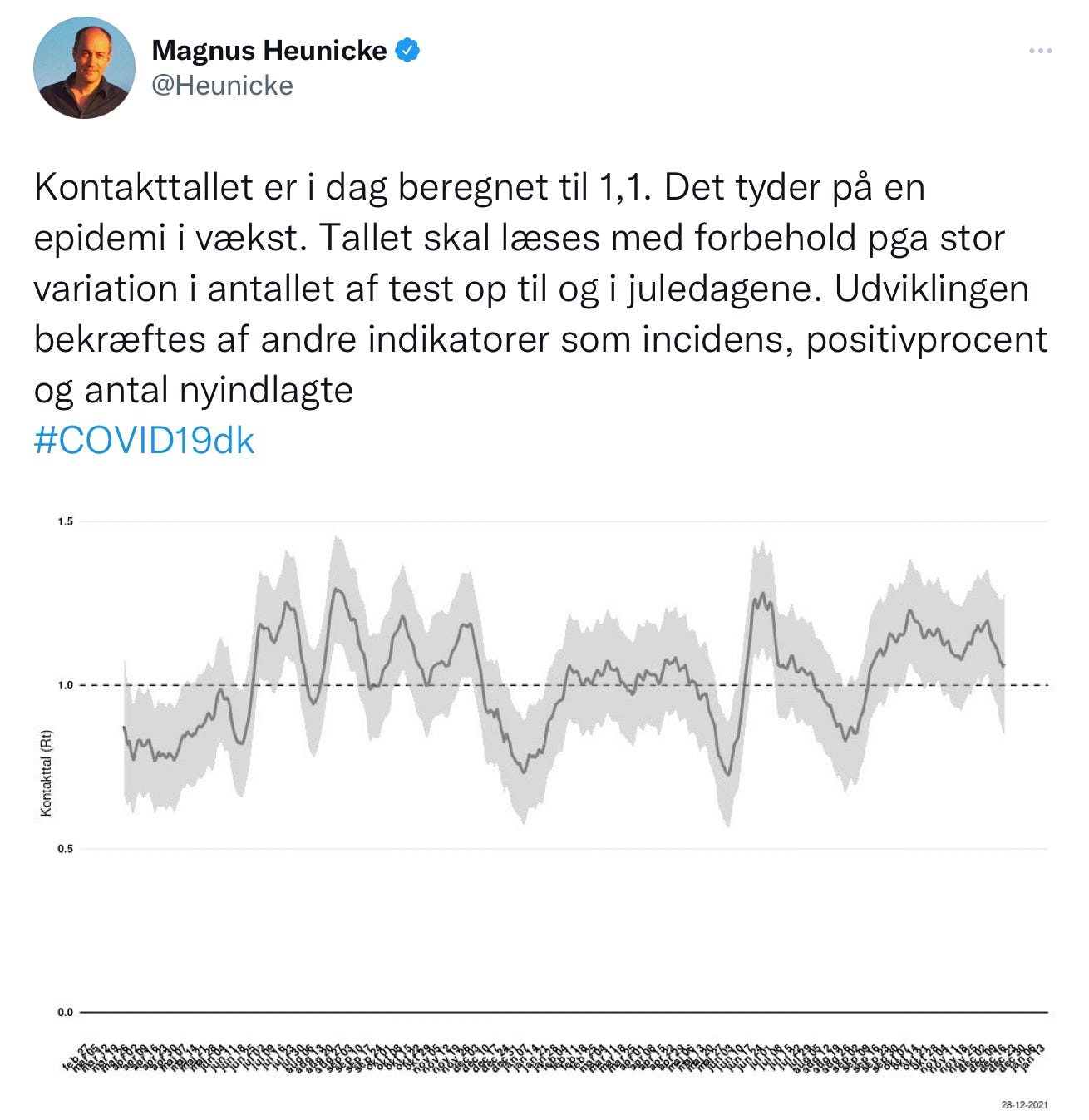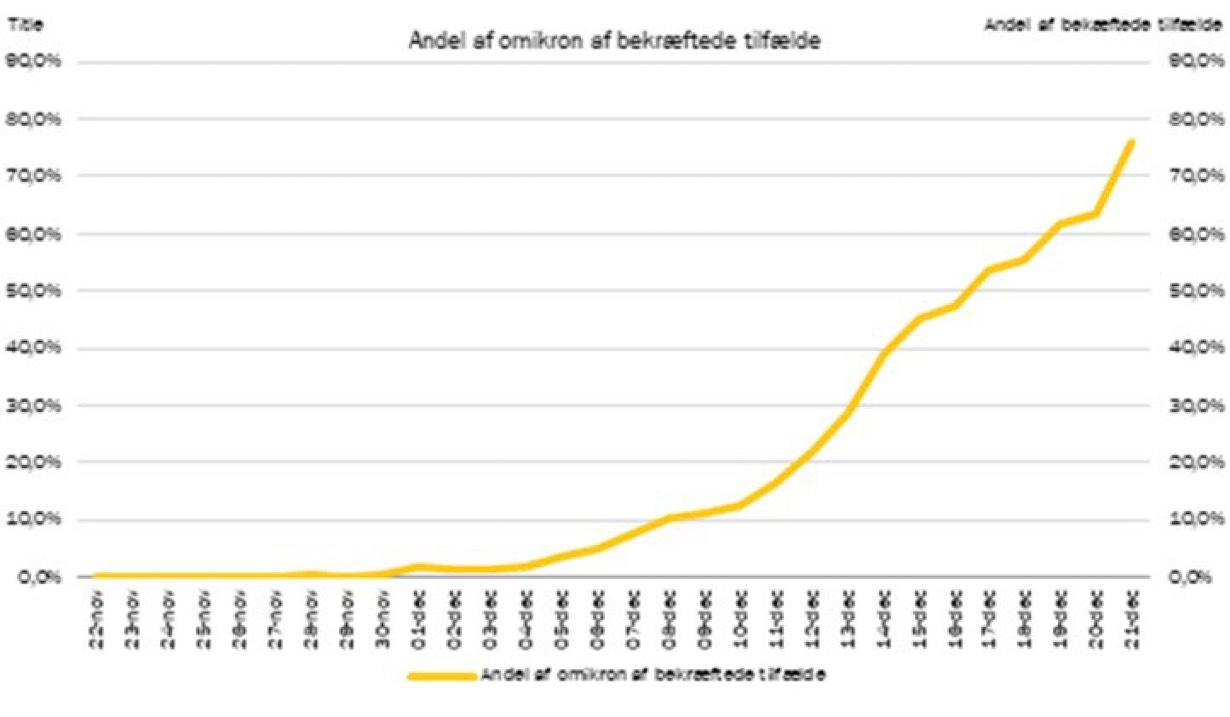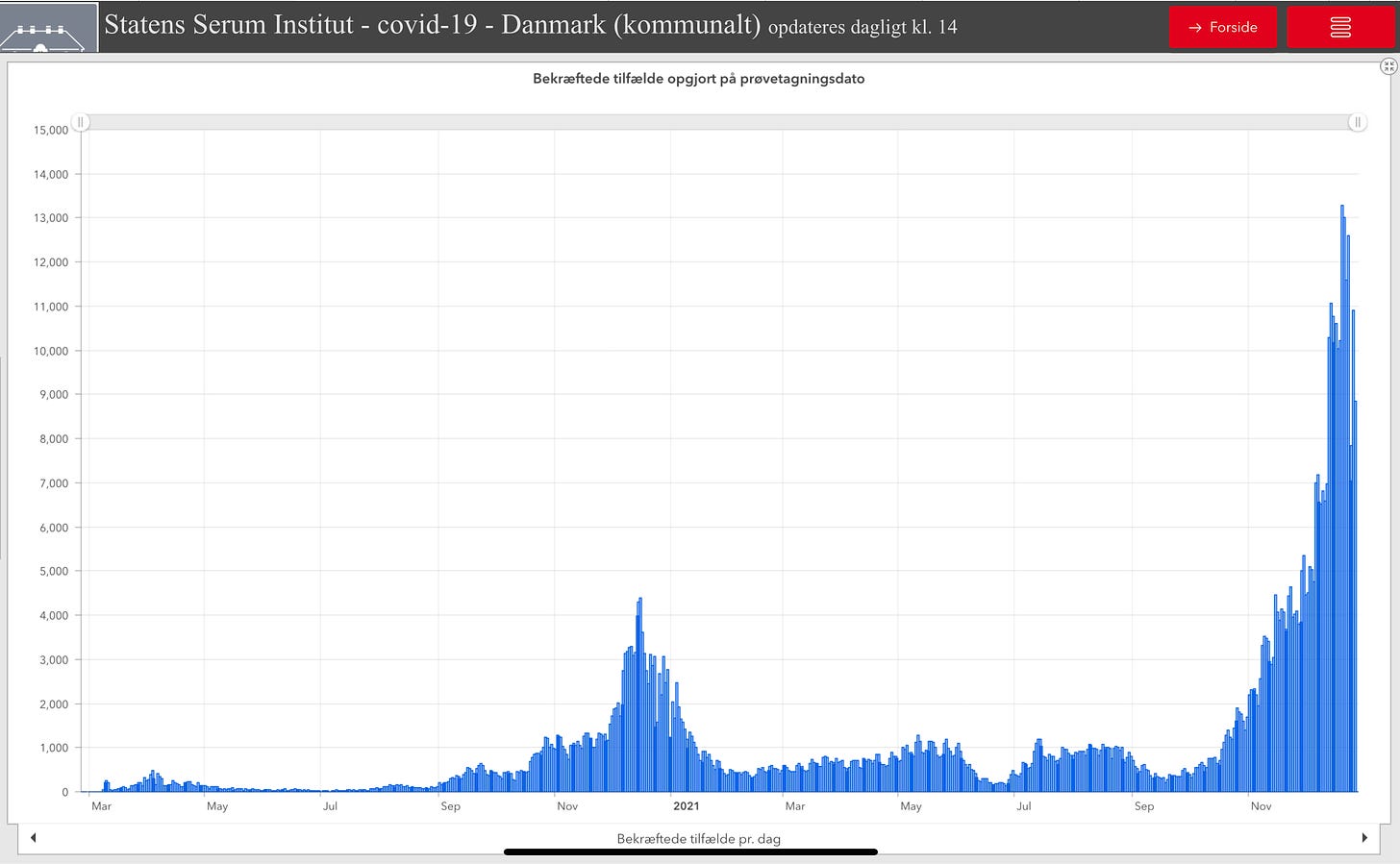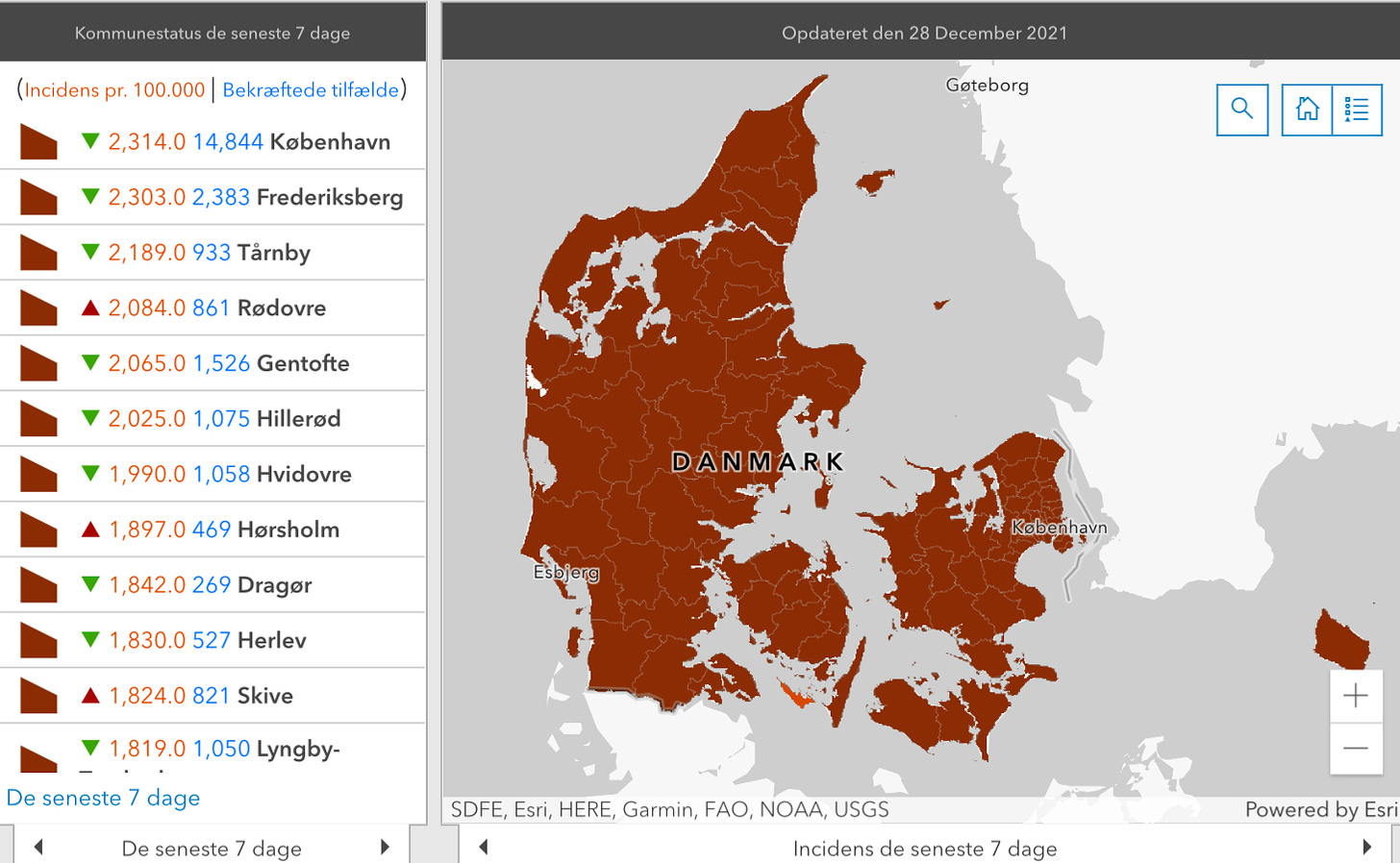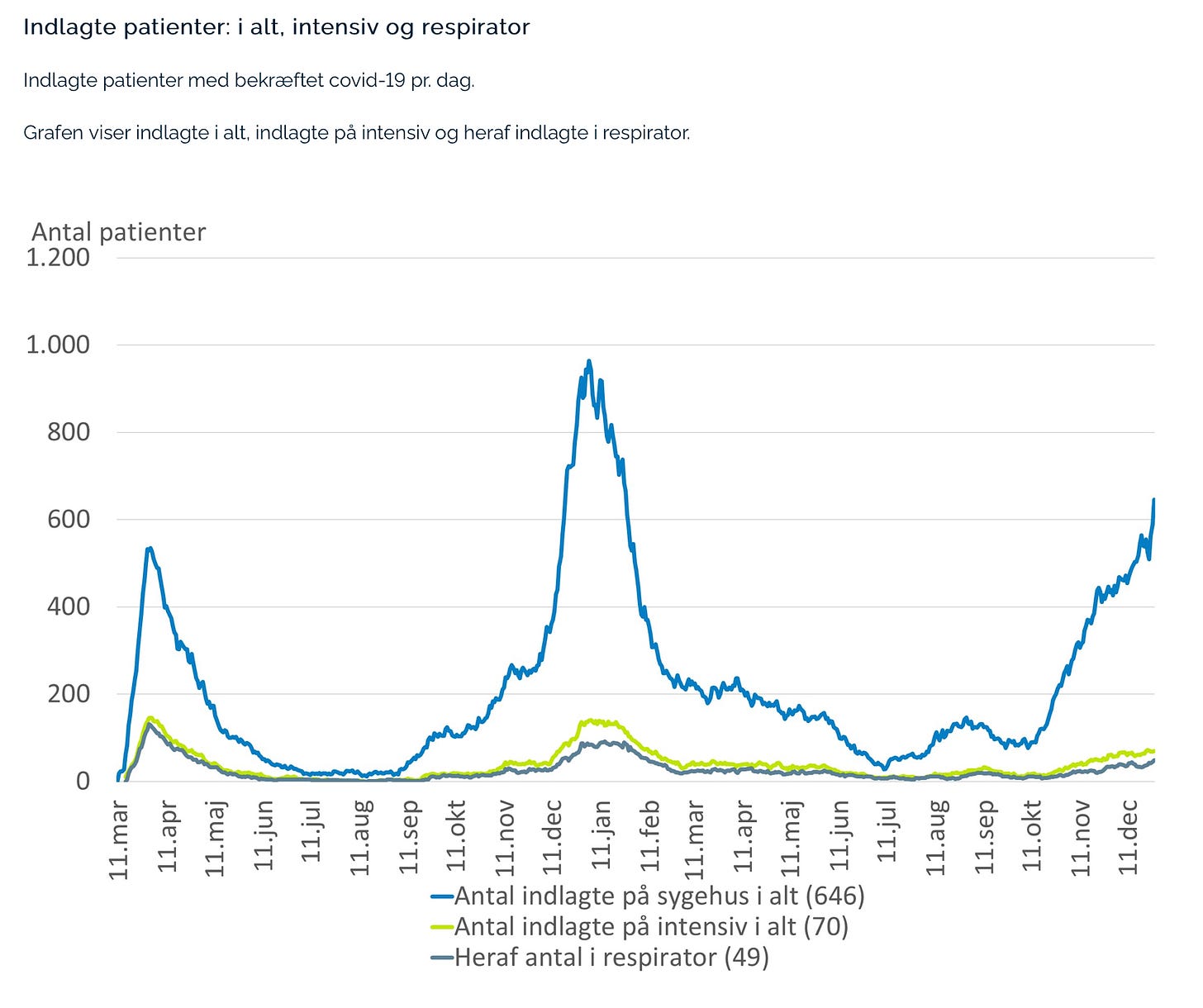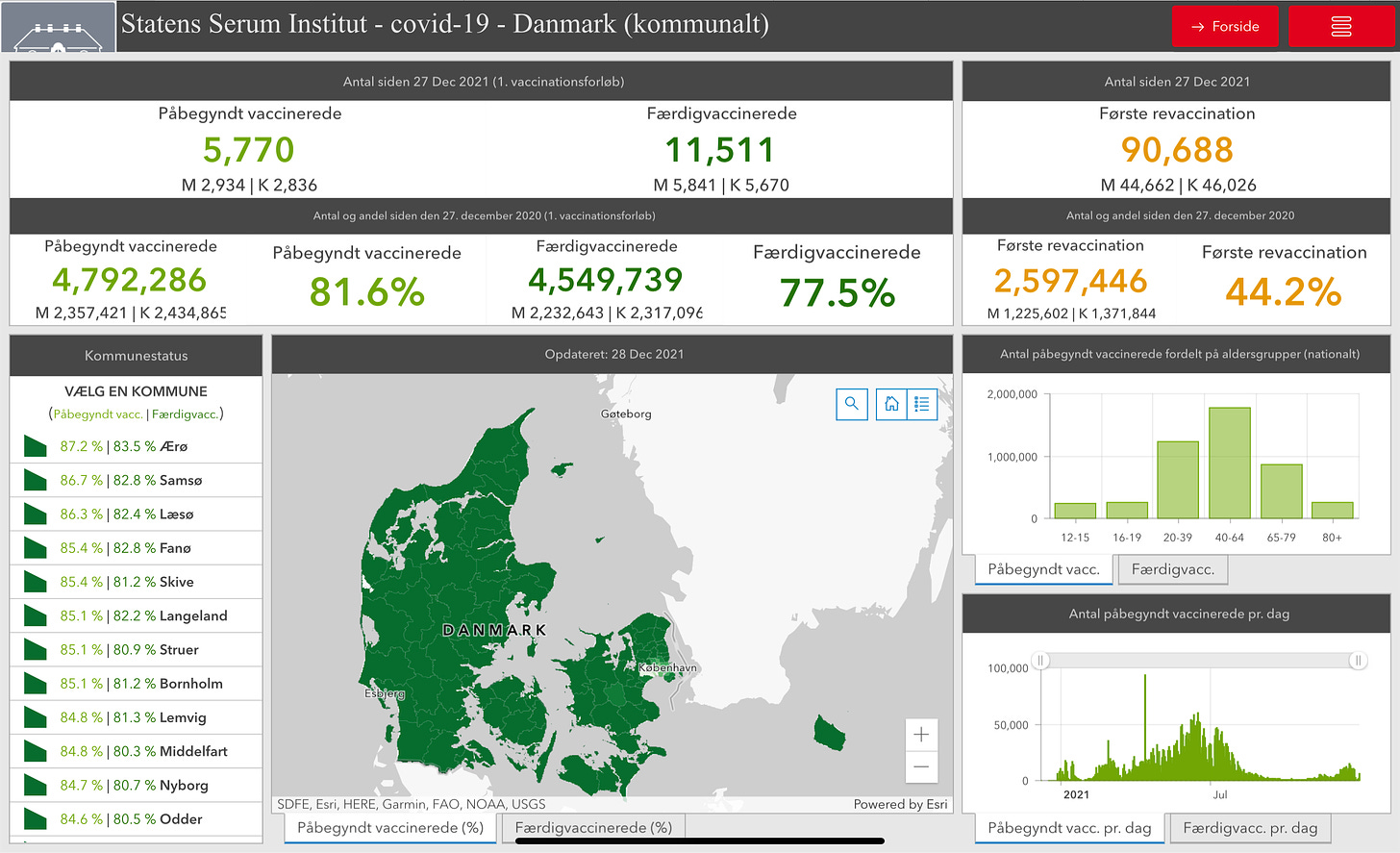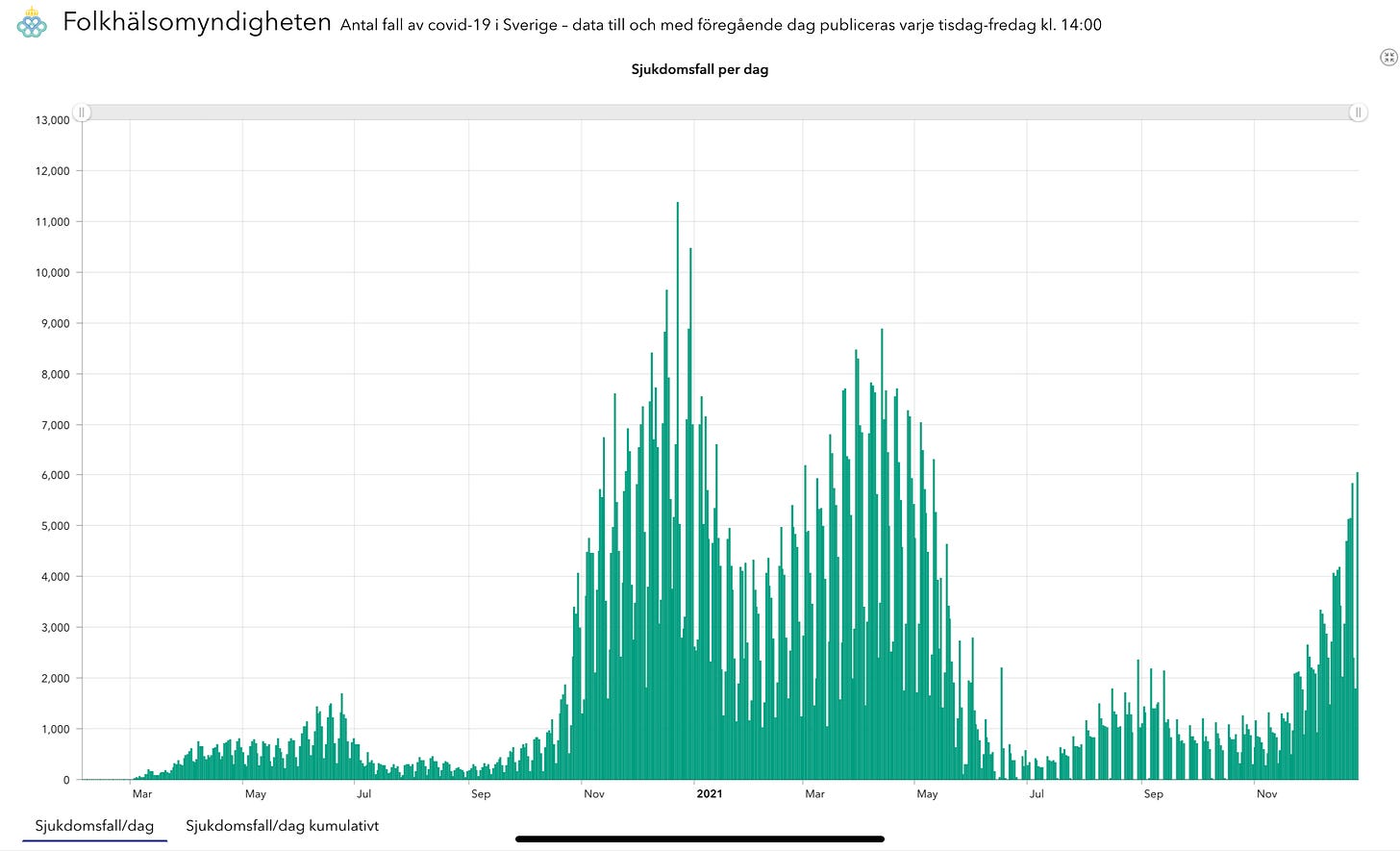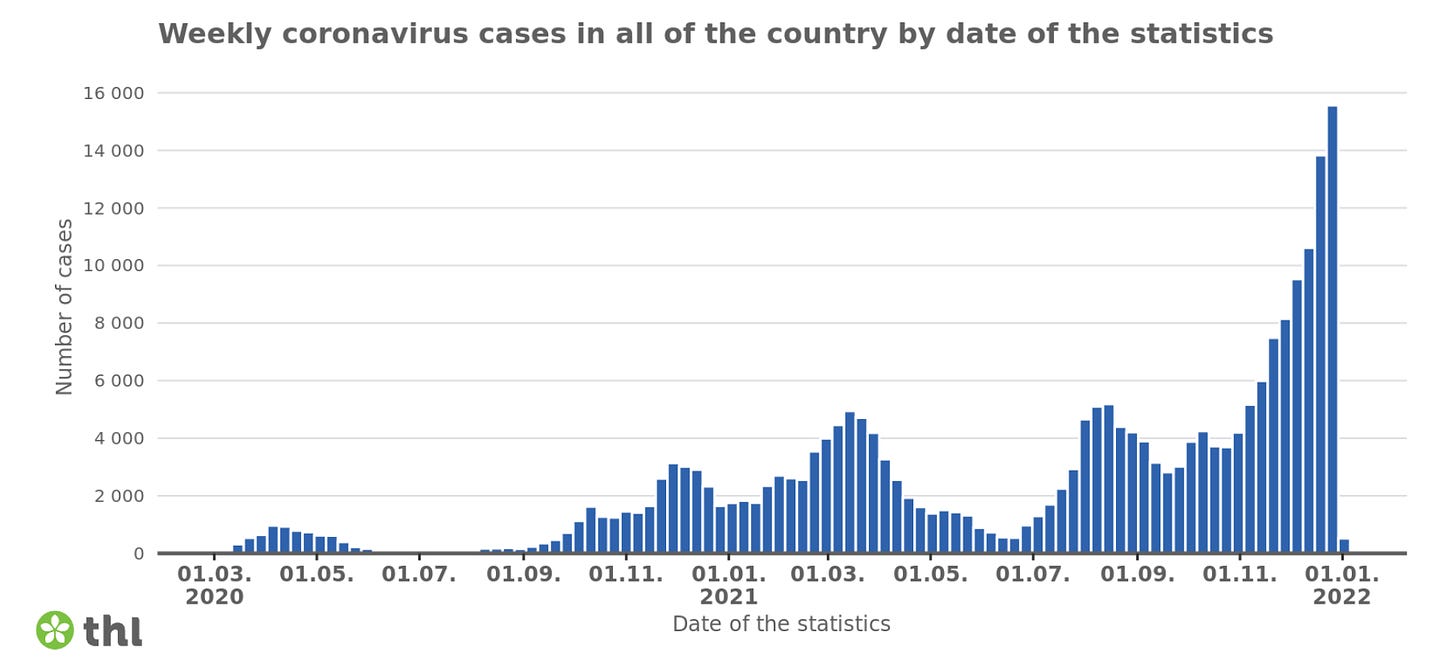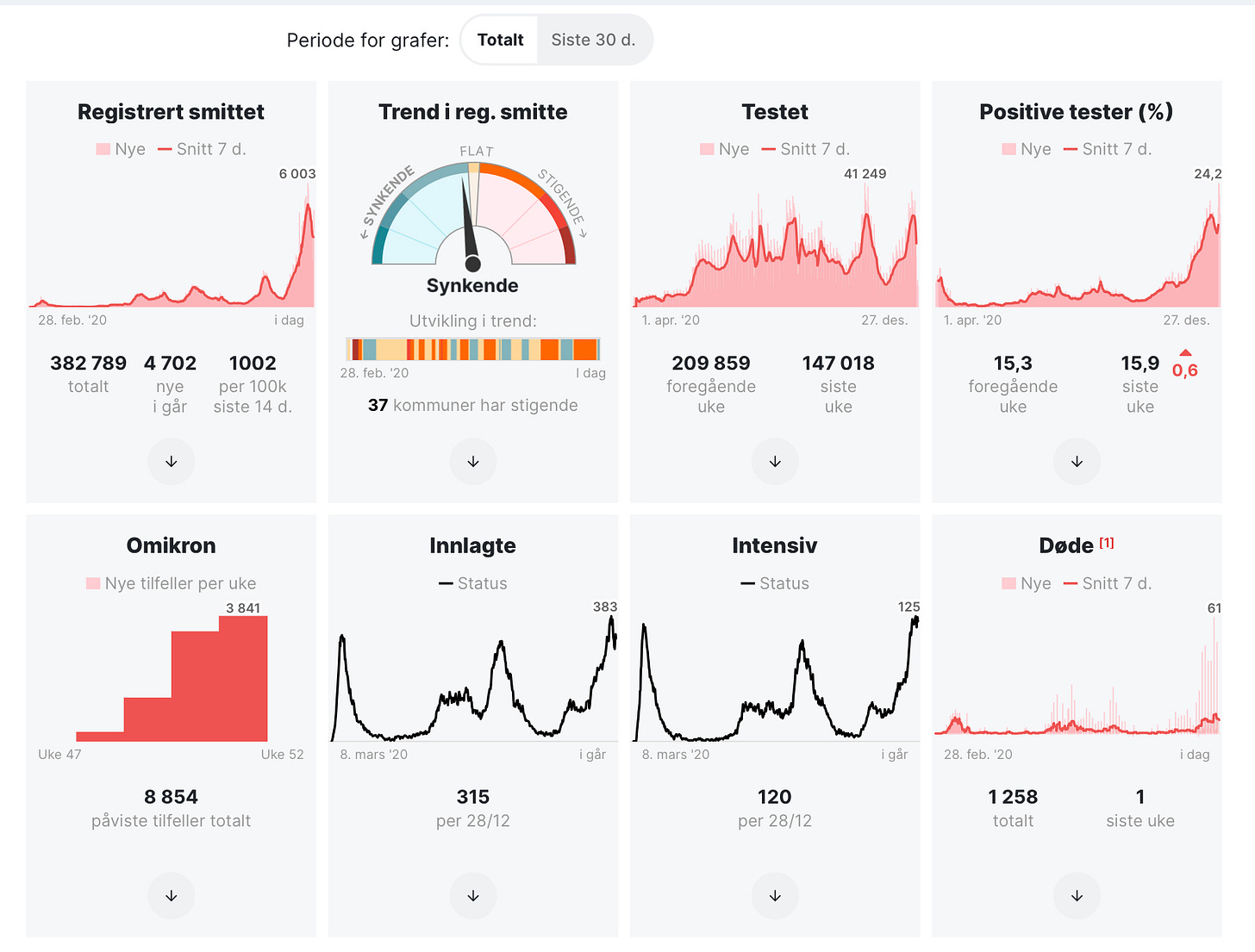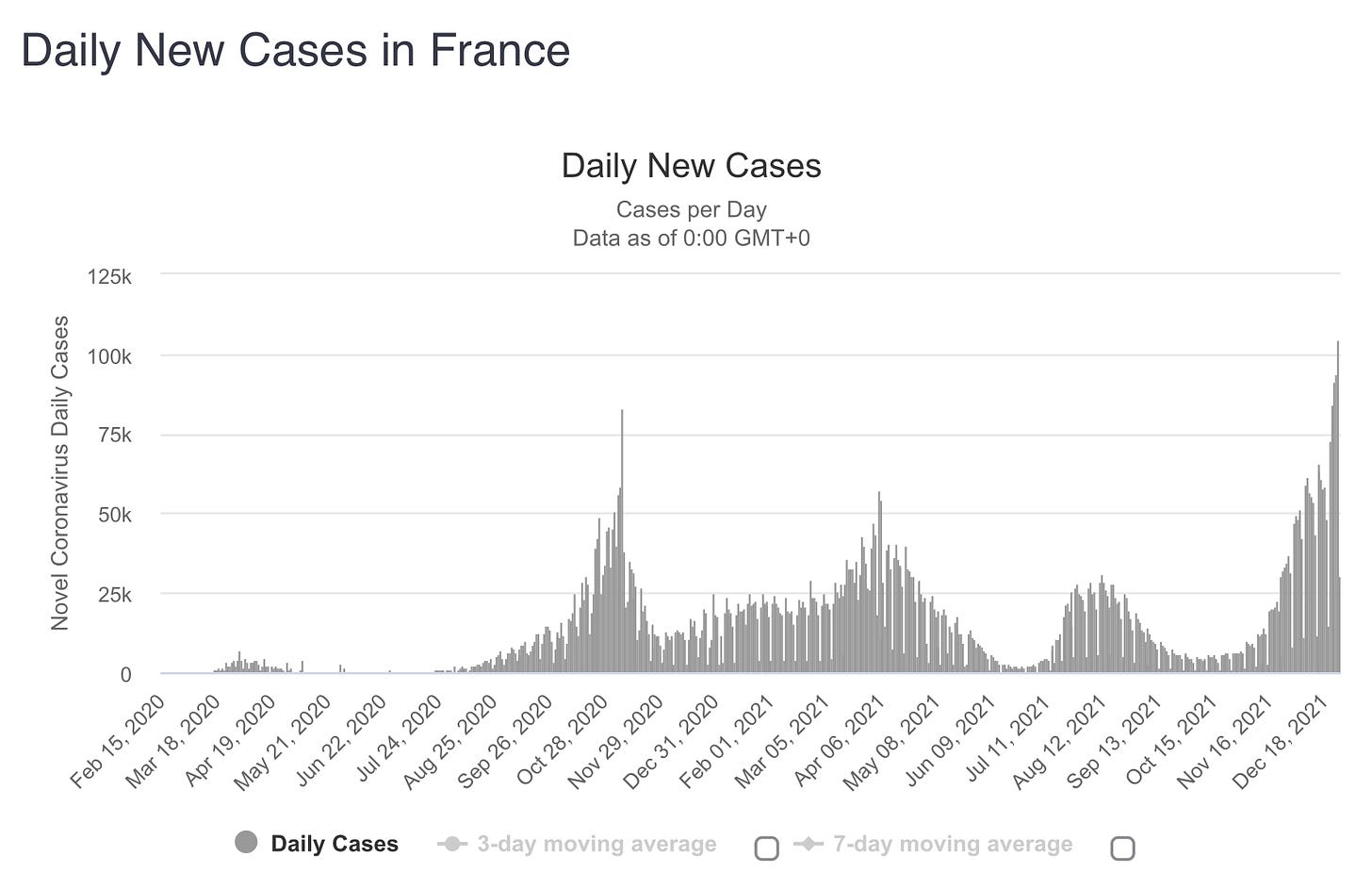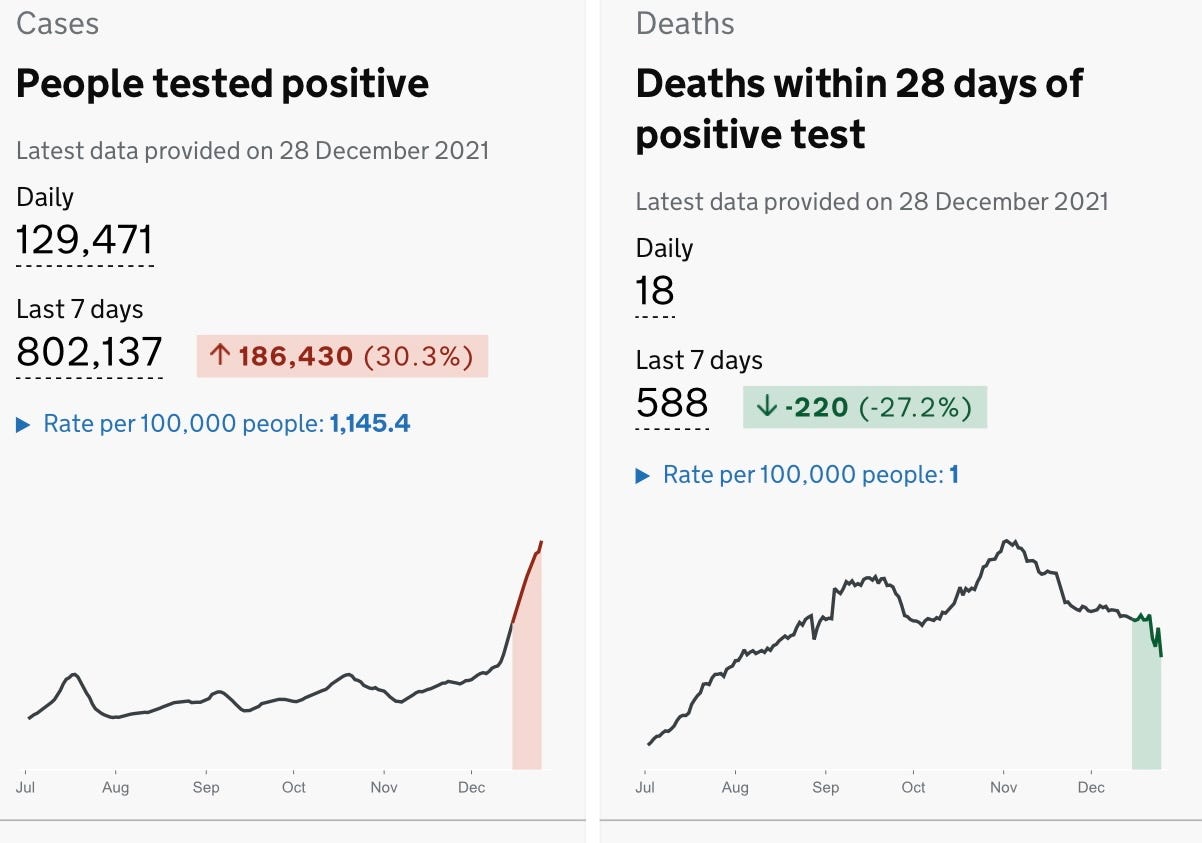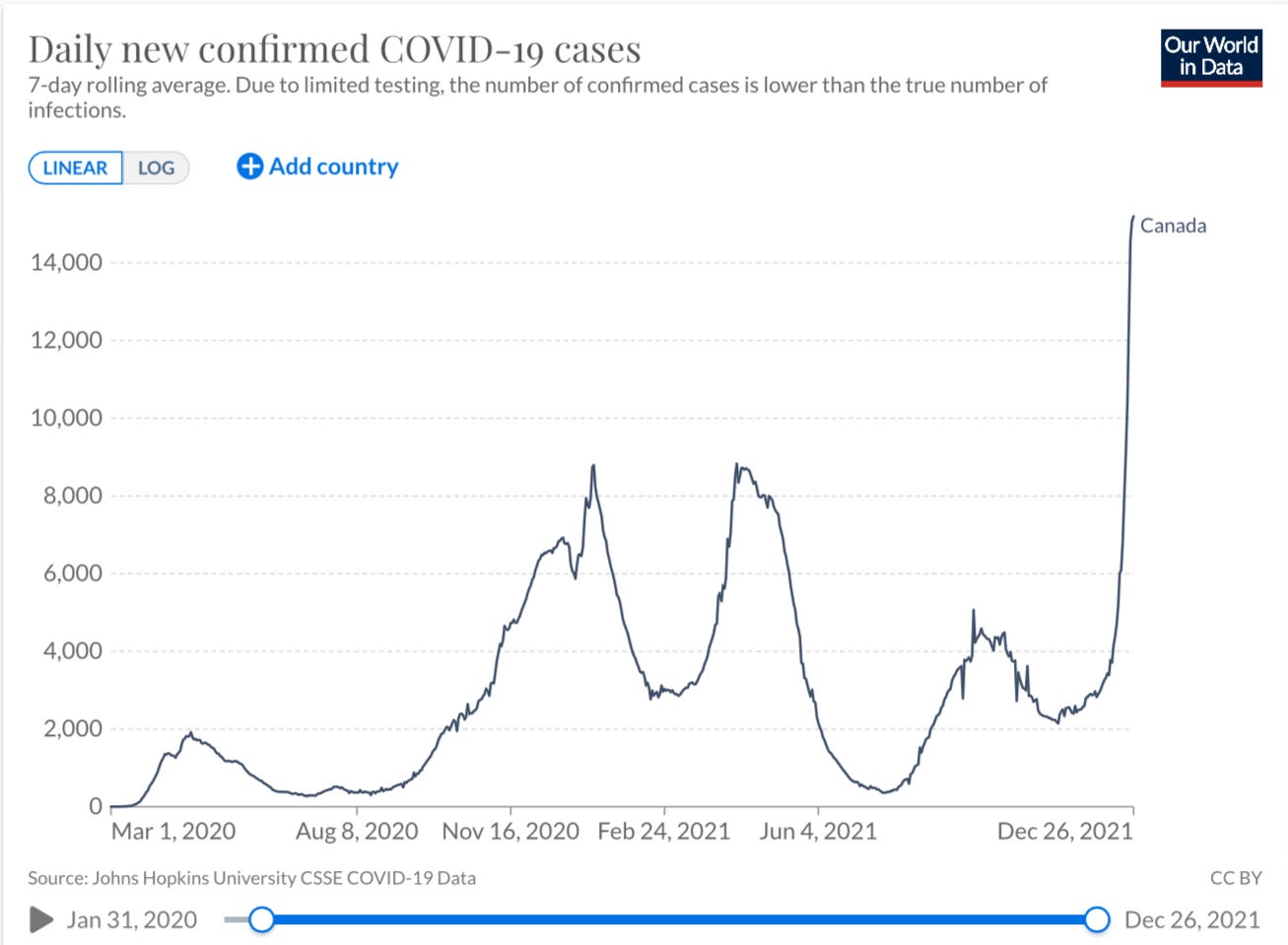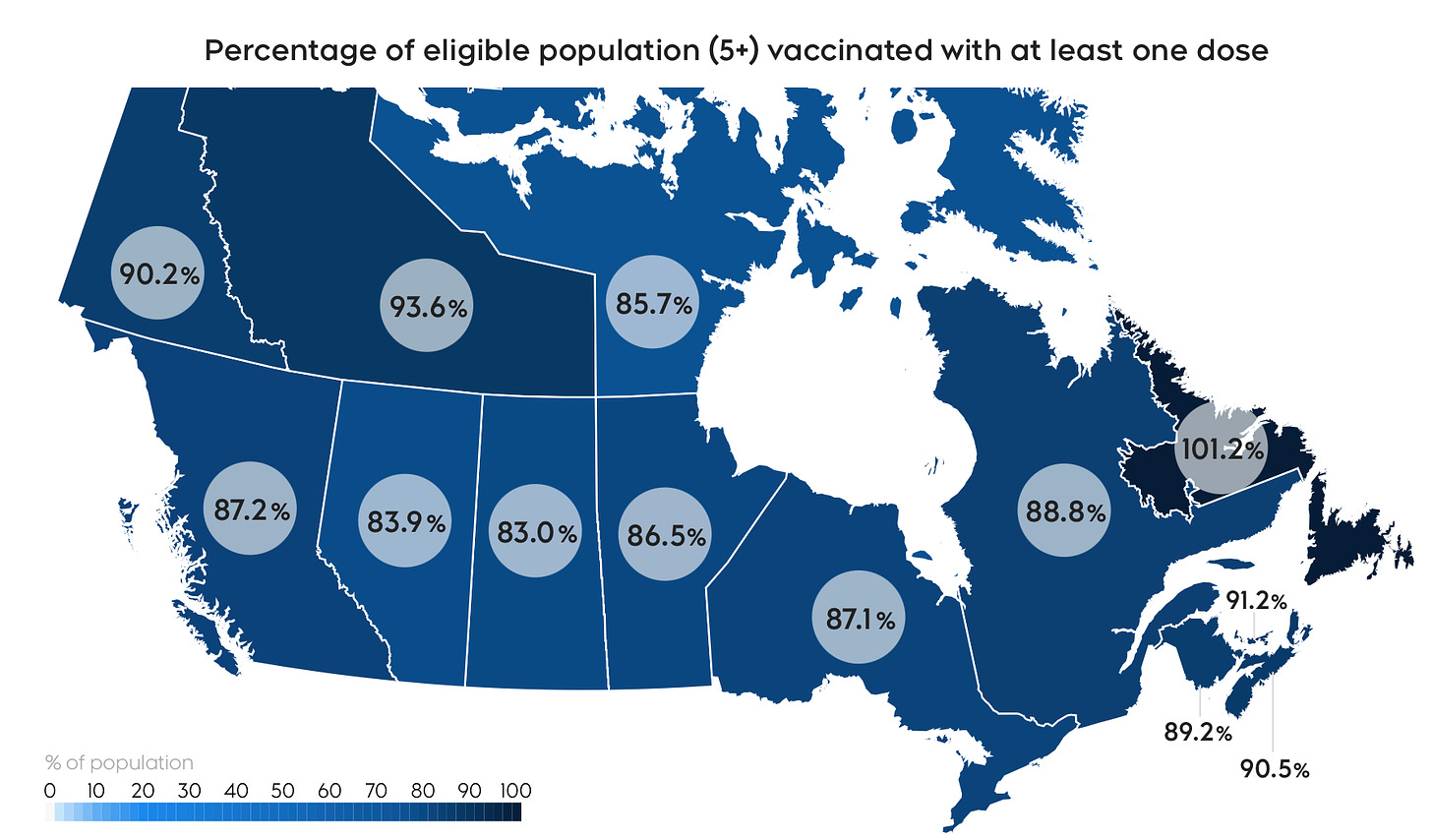🇩🇰
Denmark’s Health Minister @Heunicke says the COVID contact number (reinfection rare or R0) declined slightly from 1.2 last week to 1.1 this week but, he cautions, Denmark continues to see a growing epidemic.
-
On the Omicron variant front Heunicke says the variant accounted for 76% of all coronavirus infections as of December 21. That is just 26 days since the first two confirmed variant infections in Denmark.
-
As of December 27, Denmark has placed a COVID testing requirement on most travelers before they arrive in the country. A negative PCR test can be no older than 72 hours and a rapid test cannot be more than 48 hours old. The requirement applies regardless of vaccination status but NOT to anyone with a recent coronavirus infection.
For Danish citizens and permanent residents they will have a choice of either being tested before returning to Denmark or they can instead choose to be tested within 24 hours of arrival.
It won’t be just incoming air travelers either, as Copenhagen Deputy Police Inspector Lars-Ole Karlsen told Ritzau that people crossing land borders may also get checked.
“The idea is that we check if we get a report or in connection with other police business on the spot. Then we check whether you comply with the rule that has now been created. If you do not do that, you can get a fine.”
There are some exemptions on the testing mandate including children, people living in a border country, people transiting from Bornholm through Sweden into Denmark, truck drivers transporting goods, and people transiting through Denmark with a stay of less than 24 hours this would include air travelers transiting through Danish airports.
Non-compliance to the testing requirement will result in a DKK 3,500 fine.
-
All of Denmark is now rated at the second highest of the five-tiered COVID risk assessment. This week the Epidemic Commission raised the alert level in Region Midtjylland from 3 to 4. The other four regions were already at COVID risk level 4.
-
Denmark is increasing testing capacity again as the system strains under the pressure. Daily PCR testing capacity was pushed to 500,000 last week and by January 7 total daily testing capacity (PCR and rapid) will increase to 750,000. In addition, Denmark has purchased 65 million COVID self-testing kits, which will be distributed to the kommunes, who will then parcel them out to hospital workers, school staff, students, and for the parents of younger kids.
-
After two consecutive days of record high infection numbers including the highest daily total to date of 16,164 corona cases on Monday, Denmark is reporting 13,000 COVID cases on Tuesday, including 670 breakthrough infections, and 14 more coronavirus deaths.
Yesterday there were 315,884 total corona tests, of which 107,010 were PCR tests equaling a positivity percentage of a sky high 12.14%.
-
All but three of Denmark’s 98 kommunes have a COVID incidence rate per 100,000 people of less than 500. More than half, 57 municipalities, have an incidence rate of 1,000 or higher topped by Copenhagen with an incidence rate of 2,314.
-
When students head back to school in the new year, they will have to add COVID self-testing into their schedule alongside math, sports, and music. DR is citing the Ministry of Education in confirming a self-testing scheme will be up and running by mid-January.
Chair of the Danish Upper Secondary School Students Association Alma Tynell is happy to hear the news as it is something her group has been lobbying for.
“It is really good that our appeal has been listened to, because it is important that we have the opportunity to break the chains of infection in schools.”
The ministry says as of January 3 it will recommend that all students and staff in upper secondary schools get tested twice a week, even if they have been vaccinated or recovered from a recent infection.
Tynell says the testing recommendation and use of self-testing kits will help alleviate stress that has been building among student populations.
“Especially in December, we have experienced that many students have been worried about going to school, because there has been an enormously high level of infection in society and in some high schools. That is why it is very important that we do some things that ensure that all students can return to school safely.”
She says the self-testing kits will also mean kids won’t have to stand in long lines to get a PCR or rapid test, freeing up valuable time to focus on schoolwork.
-
The Staten Serum Institut is casting doubt on the plan to get students back to school by January 5. The agency says the vaccination rate among young children is simply too low. Since schools closed early for Christmas break, the infection situation in Denmark has gotten much worse. Vaccination uptake among children five to 11 years old is just 38.5% and the SSI’s Tyra Grove Krause told DR that is not nearly good enough.
Health Minister Magnus Heunicke agrees that the vaccination rate among young children is too low.
“We can see that it had a beneficial effect on the infection in the younger age groups that the schools were closed down before Christmas. But we still need to get even more of the youngest school children vaccinated so that the infection does not increase sharply in schools when they reopen in January. It is right now, during the holidays, that children can get vaccinated. And parents need to remember that it is possible to take siblings down to the doctor and get everyone vaccinated all at once.”
-
COVID hospitalizations (666) continue to shoot upward (+58) while the number of coronavirus infected people in an ICU (71) inched upward (+1) and of those the number on a ventilator (50) also crept up (+4).
This is the first time since January 28 that COVID hospitalizations have exceeded 600.
-
The Director of the Danish National Board of Health is warning that the hospital system is straining due to increasing COVID admissions. Already the Danish government has, for the third time in the pandemic, suspended patients rights to timely treatment in order to put all hands on deck to deal with this latest infection wave. This means even more non-urgent treatments and procedures will be delayed.
Søren Brostrøm:
“The situation is already critical now, and we expect more patients to arrive with both coronavirus and influenza.”
He says hospitals have been asked to increase capacity but there are challenges due to staffing shortages plaguing the entire healthcare sector.
“We will probably make it work, but it will have consequences.”
-
On the vaccination front the number of 3rd vaccine doses administered on Monday rose to 90,688.
So far, 81.6% of the total population have one vaccine dose, 77.5% have two, and 44.2% have had a booster shot.
-
Just before Christmas, Danish health authorities opened up access to a COVID vaccine booster dose to everyone 18 years old and older, as long as it has been four and a half months since their second shot.
Danish National Health Board Director Søren Brostrøm:
“We are in the midst of escalating infection activity, and we need to prevent both infection and disease with the Omicron variant. We do this because it is important to get the third vaccine dose now. In the middle of winter, with everything else being equal, it is expected that there will be more Omicron infections, more disease, and also influenza. All in all, it puts a strain on the hospital system.”
This week another 300,000 invitations will go out to people in Denmark to book an appointment to get a booster dose.
Health Minister Magnus Heunicke is urging people to get vaccinated, be it a first, second, or third dose, as fast as humanely possible as the Omicron variant drives infection numbers up to record highs.
“The infection is still growing. The third dose is crucial to puttimg a damper on development, and this week another very large group of Danes will be invited to get their booster dose. There are available times for vaccination throughout the country and we need to make the best use of our capacity and vaccines. Hence a clear call: Book your time and get that revaccination as soon as you can.”
Over the next seven days, it is estimated that there will be almost 380,000 vacancies nationwide in regional vaccination centers. In addition to the capacity at private clinics, pharmacies and family doctors.
-
The Staten Serum Institut is warning that some ready mixed cabbage salads may be to blame for an outbreak of E. coli that has infected 68 people so far. The cabbage salad mixes were sold in three different grocery stores, REMA 1000, Coop, and Meny, between November 15 and 30. The packages in question have a shelf life of six days, so the SSI says there is no concern anything being sold today is a concern. 20 of the 68 people have been hospitalized. E. coli is an intestinal infection spread through tainted food that can cause things like stomach aches, diarrhea, vomiting, and a fever.
🇸🇪 🇩🇰
Prepare for long lines crossing into Sweden from Denmark over the Oresund bridge and even for those traveling into Sweden by train. A negative COVID test is now required to enter the country for everyone 12 years old and older.
Head of Sweden’s Southern Border Police Mats Berggren:
“Travelers will experience a high presence at the border in the South region. We do not advise anyone to take a chance on entering Sweden without having the required certificates.”
He says police have increased staffing to help tackle the increased workload but even then delays are expected for anyone arriving by plane, ferry, train, or car.
“Checking negative COVID tests must be done manually and takes time. Unfortunately, travelers can count on queues, both at the Öresund Bridge in rush hour traffic and at Hyllie, where we control train passengers traveling in from Denmark.”
Regular commuters have a slight exemption. They can show either proof of vaccination or a negative COVID test no more than one week old.
The other exception is for people who can prove they are entering Sweden for the express purpose of traveling between Bornholm and Denmark.
🇸🇪
The Omicron surge has arrived in Sweden as it added 21,247 corona infections and another 21 deaths since its last update on Friday. b
To date, 7,746,286 1st vaccine doses (85.7% of the population 12 years old and older) and 7,370,712 2nd doses (81.6%) have been administered. Of those 18 years old and older with two doses 2,399,970 (28.9%) have had a booster dose.
-
Hospitals in Sweden’s capital region continue to strain as COVID infections and admissions continue to be driven up by the Omicron variant.
Last week, the region confirmed 9,649 new infection cases, a clear increase from the 7,335 from the week before.
Region Stockholm Infection Control Doctor Maria Rotzén Östlund:
“We now have almost 10,000 confirmed cases per week. The number of confirmed cases is increasing week by week. We see no signs that it is about to slow down. It is worrying.”
The region estimated that the Omicron variant would soon account for 60% of all sequenced positive test results.
The numbers are not anymore promising when it comes to hospital admissions. There were 243 COVID patients admitted last week, an increase of 67 from the week prior.
Chief Physician Patrik Söderberg:
“We have a very strained situation at the county's emergency hospital. Danderyd Hospital, Södersjukhuet, and Capio St. Göran's Hospital are all still in staff mode to meet patients' needs for care. The is a large increase in the number of patients with COVID and at the same time we have many patients with seasonal flu.”
He cautions people to be cautious over New Years not only to avoid any unnecessary injury, further adding to the burden on hospital staff, but also to guard against coronavirus infection.
The number of COVID tests in Region Stockholm tumbled last week to just 63,150 compared to almost 90,000 the week before. Even then, the region’s positivity percentage was 13.8%.
-
A doctor is headed to jail and his clinic has filed for bankruptcy after issuing falsified COVID test results, according to Swedish newspaper Göteborgs-Posten. The clinic in Gothenburg has been charging people between 1,590 and 3,690 Swedish kroner for COVID PCR tests but it hasn’t actually analyzed a single test result and instead just issued falsified negative test results. The doctor behind the clinic was sentenced to a year in jail for charges including fraud. His clinic has now declared bankruptcy as it faces ongoing debts and mounting financial consequences.
🇫🇮
Finland has registered 2,714 new infections and three more virus deaths since yesterday’s update.
COVID hospitalizations (307) are unchanged.
So far, 77.3% of the total population have one vaccine dose, 73.6% have two, and 17.4% have had a booster dose.
-
Finland has tightened COVID restrictions including at its borders. In areas deemed to be in a “community transmission phase” of Finland’s three-tiered COVID alert system restaurants and other businesses largely reliant on alcohol sales must stop selling booze by 5pm and close by 6. Restaurants requiring guests to show a coronapas can remain open until 8pm. In at least one region, Uusimaa, all indoor public events and meetings are banned and public and private sporting activities are also closed.
According to YLE, border restrictions have also been tightened with a requirement for all travelers coming to Finland from the Schengen area to show proof of vaccination, or proof of recent recovery, as well as a negative COVID test no more than 48 hours old. The test result mandate does not apply to Finnish citizens and permanent residents. The Schengen zone covers almost all European countries with the exception of Romania, Bulgaria, Croatia, Cyprus, Norway, Iceland, Switzerland, and Liechtenstein.
🇳🇴
Norway has added 4,702 infections and one more corona death in the last day.
It has confirmed 8,854 cases of the new Omicron variant to date.
COVID hospitalizations (315) and ICU numbers (1#0 are both unchanged day to day.
So far, 79.4% of Norwegians 12 years old and older have had one vaccine dose, 72.6% have two, and of those 27.2% have a booster dose.
🇩🇪
Germany tightened restrictions again this week. Private gatherings have been capped at ten people if all ten are vaccinated or have had a recent infection. For the unvaccinated private gatherings can only include a maximum of two visitors from outside the household. In some German states, gyms, public swimming pools, nightclubs, and movie theaters have been closed. Restaurant hours may also be limited. For a second year in a row, New Year’s fireworks are a no-go. This is in addition to mask mandates on shops and on public transit, as well as coronapas requirements for venues and some public events.
-
Debt free thanks to the Pfizer/BioNTech vaccine. That is the situation the German town of Mainz finds itself in. The town is where the vaccine maker is based, and while Mainz has been plagued by debt woes for the last three decades, an injection of increasing tax revenue from Pfizer should allow Mainz to clear its accounts in the New Year. To give you some idea of the cash cow the town has on its hands, it had a deficit of some €36 million in 2021, and thanks to tax revenues from BioNTech it stands to table a surplus of €1.09 billion in 2022.
🇫🇷
The Omicron variant is sending new infections to never before seen heights in France. On Tuesday, it reported a record high 179,807 new infections and 290 more deaths
France is looking to remove the negative test requirement from vaccine passports in a move aimed directly at those who have not yet chosen to get vaccinated. The French government would like to have the new measure in place by January 15, pending parliamentary approval. Currently, vaccine passport requirements include proof of vaccination, proof of recovery from a recent infection, or a recent negative COVID test in order to access events. If the measure passes this would put France in line with Germany, Switzerland, and Austria in removing the negative test requirement in order to try and incentivize holdouts to get vaccinated.
🇬🇧
In the United Kingdom, new COVID restrictions are being introduced by Wales, Scotland, and Northern Ireland this week, while England is ruling out any new measures until possibly the new year. Wales, Scotland and Northern Ireland are imposing social distancing requirements and capacity limits on cultural institutions and social events.
This is as the UK continues to see record high COVID numbers. On Tuesday it registered its highest daily total yet, with 129,471 new cases and 18 new deaths.
🇨🇦
While the Canadian government’s COVID dashboard hasn’t been updated since December 23rd, this graph from Our World in Data gives you a sense of the impact of the massive Omicron variant infection surge.
On the vaccination effort to date, 31,522,152 1st vaccine doses (82.44% of the total population) have been administered while 29,348,866 people (76.76%) have had two doses, and of those, 6,005,014 people have had a booster shot.
In Ontario Tuesday, there were 8,825 new infections as case numbers soar. There are 491 people in hospital and 187 in an ICU.
Quebec reported 12,833 new infections and 15 more corona deaths. There are 702 people in hospital (+88) and 115 in intensive care (+6). The province has asked Ottawa for federal assistance as it battles by far its worst infection wave yet.
In Atlantic Canada, Prince Edward Island saw a record high 118 cases. New Brunswick had 306. Nova Scotia saw 561 infections. Newfoundland and Labrador had 194.
Manitoba saw a record high 825 infections and five more fatalities.
Saskatchewan recorded 896 COVID cases over the last five days along with two more corona deaths. Wastewater monitoring in the province has shown an 800% increase in Omicron variant activity in just the last week.
Alberta logged 8,250 new COVID cases in a period covering the last five days. But due to testing regime changes, this number is likely underreported.
B.C registered 1,785 new infections, but its testing system has pretty much collapsed, meaning the number of reported cases is likely not even close to being accurate.




